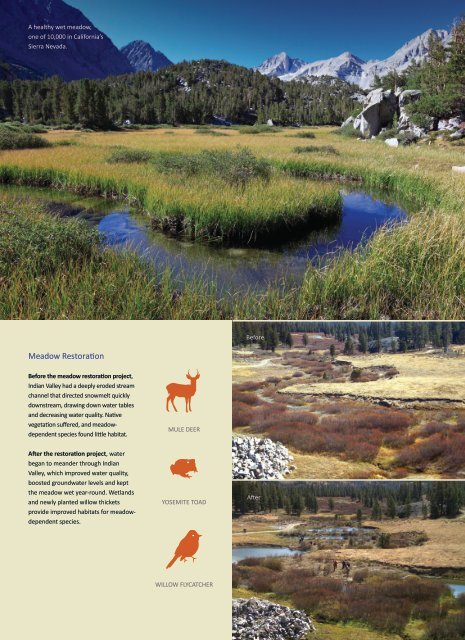NATIONAL FISH AND WILDLIFE FOUNDATION
2015_annual_report
2015_annual_report
You also want an ePaper? Increase the reach of your titles
YUMPU automatically turns print PDFs into web optimized ePapers that Google loves.
A healthy wet meadow,<br />
one of 10,000 in California’s<br />
Sierra Nevada.<br />
LEADING THE EFFORT TO RESTORE<br />
WET MEADOWS<br />
In 2015, intense drought conditions and contentious waterrelated<br />
issues dominated the news in California and many other<br />
western states.<br />
But state leaders and federal forestry officials found new cause for optimism high in<br />
the Sierra Nevada. There, in the Eldorado National Forest’s Indian Valley, NFWF’s early<br />
investments in the restoration of alpine meadows were paying dividends.<br />
Degraded by a long history of legacy mining, road building and overgrazing, this “wet<br />
meadow” had essentially turned dry. Water from rain and snowmelt no longer meandered<br />
through the valley but instead ran quickly downhill, causing erosion and worsening water<br />
quality for people and wildlife downstream. Such deterioration can be found at the<br />
majority of the 10,000 meadows in the Sierra Nevada.<br />
Meadow Restoration<br />
Before the meadow restoration project,<br />
Indian Valley had a deeply eroded stream<br />
channel that directed snowmelt quickly<br />
downstream, drawing down water tables<br />
and decreasing water quality. Native<br />
vegetation suffered, and meadowdependent<br />
species found little habitat.<br />
MULE DEER<br />
Before<br />
“Meadows are an important part of California’s water infrastructure,” said Luke Hunt,<br />
director of headwaters conservation for American Rivers and the project lead for the<br />
heralded Indian Valley meadow restoration project. “Meadows save water, they provide<br />
incredible habitat for wildlife, and they do both at the same time.”<br />
Using a restoration technique designed to reroute streamflow, Hunt’s group worked with<br />
the U.S. Forest Service, corporate partners and a host of volunteers to create a series of<br />
small wetlands throughout Indian Valley. The project, which began in 2012 and underwent<br />
major construction in 2013, restored the meadow’s natural functions, allowing water to<br />
seep into the ground.<br />
With 2015 funding from NFWF, Hunt’s group continued to replant willows along the sloweddown<br />
stream while scientists monitored and documented the results of the restoration<br />
project. What they have found so far captured the attention of state and federal officials.<br />
“The meadow really is working like a sponge, storing water for use late in the summer,”<br />
Hunt said. “It’s wet in the worst drought that any of us could imagine.”<br />
29<br />
After the restoration project, water<br />
began to meander through Indian<br />
Valley, which improved water quality,<br />
boosted groundwater levels and kept<br />
the meadow wet year-round. Wetlands<br />
and newly planted willow thickets<br />
provide improved habitats for meadowdependent<br />
species.<br />
YOSEMITE TOAD<br />
After<br />
Before the project, the stream would go dry by midsummer. Now it flows year-round. As a<br />
result, improved habitats now provide forage and cover for wildlife ranging from mule deer<br />
and yellow warblers to imperiled species such as the Yosemite toad and willow flycatcher.<br />
In 2015, California incorporated wet meadow restoration into its State Water Plan.<br />
“NFWF helped prove that meadow restoration works,” Hunt said. “They addressed<br />
the bottlenecks — prioritization, design and permitting — and set the stage for<br />
state investment in shovel-ready meadow restoration. Now meadow restoration<br />
is happening across the Sierra.”<br />
WILLOW FLYCATCHER<br />
CONTRIBUTING PARTNER U.S. Department of Agriculture’s U.S. Forest Service,<br />
U.S. Department of the Interior’s U.S. Fish and Wildlife Service


